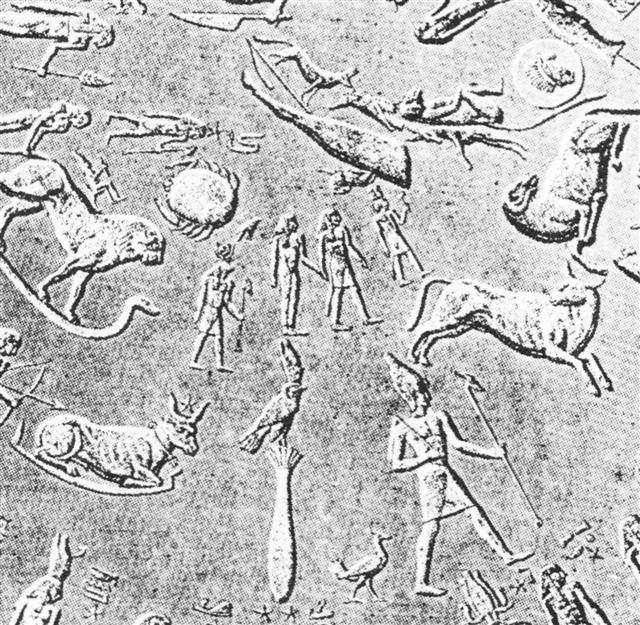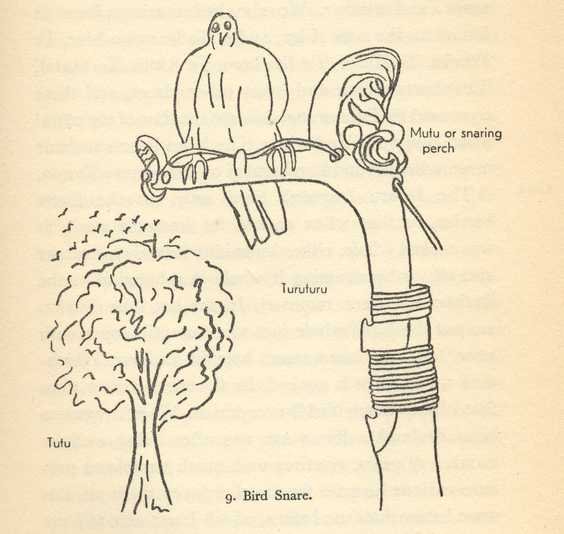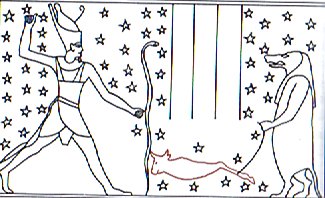8. The perching bird at the top of the pole in the
round Dendera Zodiac is not moving, it is not the picture of a manu
rere. He is more like a stuffed up old bird, just an image (manu
uru):

| Manu
1. Bird; manu uru,
bird figure (like the drawings or wooden figures once
found in caves and houses); manu va'e e-há,
four-legged bird (name given to the first sheep introduced
to the island. 2. Insect. manupatia, wasp. 3. Bird's
egg: mâmari manu. 4. Wild, untamed. 5. Song in which
is expressed the desire to kill someone, or in which a crime
is confessed: he-tapa i te manu (see tapa).
Bird; manu uru, kite; manu
rikiriki, insect. P Pau.: manu, bird, insect,
brute. Mgv.: manu, bird, beast. Mq., Ta.: manu,
bird, insect. Manu nave, great abscess, bubo.
Manu i te raá =
comet. Manu vae eha, 'birds with four legs'. |
At summer solstice Spring Sun does not move any
more, he has changed from being a manu rere (or a manu kake) to a manu uru.
Maybe he has been caught in a trap. The word uru could have
been used as a sign to indicate this standing still status, e.g.
when the turtle of the explorers returned into the water after
having immobilized Kuukuu:
| After he had lifted the
turtle a little bit, he pushed her up farther. No sooner had
he pushed her up and lifted her completely off the ground
when she struck Kuukuu with one fin. She struck
downwards and broke Kuukuu's spine. |
he iri ka iri era ka
avaava ro.etahi no o kapeu i pua mai era kia kuukuu.he ava
ki raro he hati te tua ivi o kuukuu. |
| The turtle got up, went back
into the (sea) water, and swam away. |
he ea te honu he
uru ki roto ki te vai he oho. |
Orion was imagined as a bird snare by the Maori, a
place where the 'bird' got stuck and couldn't move away:
"Pewa-o-Tautoru,
Bird-snare-of-Tautoru; the constellation Orion in New Zealand. The
Belt and Sword form the perch, te mutu or te teke,
while Rigel is the blossom cluster, Puanga, used to entice
the unsuspecting bird. To visualize the bird-snare we must remember
that Orion, as we see it in the northern hemisphere, is upside down
to the view obtained from New Zealand where Orion stands in the
northern sky." (Makemson)

(Picture from Text
Centre, http://www.nzetc.org/.)
Makemson's remark also means that for the Maori the
belt stars were not down in the 'water' (below the ecliptic or below
the celestial equator) but up on 'land'.
Maybe Sirius (Reitaga on Easter Island) was
imagined as the 'pigeon' who had been caught in the snare. The fame
of this star is based not
only on its brightness but also on its power to remain standing still in
spite of the precession (it was so in ancient Egyptian times).
Taga means 'sack', and Spring Sun possibly was put into a sack
after having been caught, at least he is no longer seen because of
the rain clouds:
| Taga
1. Act, business, anecdote; taga poki,
anecdote, nonsense, story, puerile, childish. 2. Sack. PS
Sa., Fu., Niuē, Viti:
taga, a bag. To.:
taga, the colon;
tagai, a sack.
Churchill. |
The snaring perch was named mutu, we can see
from the picture. This word suggests that Spring Sun has not only
stopped in his track but also totally disappeared, because Mutu
is the name of the 29th black night, the night when Sun went
on the back of Moon.
|
Mutu 1. Cut short, shortened,
amputated; at an end, ceased; anything cut off short; short,
brief, quick (rare). Ua muku ko'u lole, my
dress is shortened. He kanaka wāwae muku, a person
with amputated foot. Huli muku a'ela nā wa'a, the
canoes turned sharply. (PPN mutu.) 2. A measure of
length from fingertips of one hand to the elbow of the other
arm, when both arms are extended to the side. 3. Broken
section of a wave or crest. See lala 1. 4. Same as
Mumuku, a wind. 5. Thirtieth night of the moon,
when it has entirely disappeared (muku). 6. Starboard
ends of 'iako (outrigger booms), hence starboard
sides of a canoe. |
Another name for Sirius on Easter Island was Te
Pou (the pole), i.e. the name of the 7th kuhane station:
|
Along the southern coast - 1st part: |
|
5 Te Piringa Aniva |
6 Te Pei |
7 Te Pou |
|
Along the southern coast - 2nd part: |
|
8 Hua Reva |
9 Akahanga (†) |
10 Hatinga
Te Kohe |
The location of the kuhane
station Te Pou at the end of the first
half of the southern coastline makes sense. 7 is
half 14 and Te Pou probably therefore
marks the halfway point in the cycle of 14 * 29.5 = 413 nights,
when Moon
will turn around from waxing to
waning.
Beyond 7 Te Pou comes
8 Hua Reva - the uplifted Mercury 'fruit' -
and the corresponding Dendera constellation (to
the left of manu uru perching on his pole)
is the uplifted 'cow', presumably the Bull of
Spring now calmly lying down after having lost
his 'front leg' - changed his sex. His lost
great 'front leg' is depicted as a hind leg
close to the northern pole. This enigmatic
constellation was depicted as if snared by a
hippopotamus (like the turtle a beast living at
the border line between land and water, life and
death):

We can count the number of stars
as 18 (at the back side of the man) + 13 (close
to the head of the hippopotamus) + 9 (around the
leg of the bull) + 1 (below the front arm of the
man) + 5 (to the right of the serpent) + 10
(close to the face of the man) = 56.
These 56 stars can be ordered
into groups in any number of possible ways, and
the only we can say with certainty is that there
is a single star below the man's front (closed)
hand, 56 = 'one more' than 55.
I find it plausible to group this
single star together with the 9 stars around the
leg of the bull. The Bull of Spring is finished
(9) but he has sired a new generation (1).
Van Tilburg describes eloquently where Te Pou
had its place according to Polynesian thought:
|
The higher-ranked of the two largest political units on
Rapa Nui was the Ko Tu'u Aro Ko Te Mata Nui.
This literally translates as The Mast/Pillar/Post
[standing] Before the Greater Tribes.
Toko te rangi,
or Sky Propper, is named by Métraux in his corrected
Miru genealogy as the thirteenth king of Easter
Island and as one of the lineages or subgroups of the
Miru. Although we have no record of the Sky Propper
legend on Rapa Nui, other Polynesian legends of
the Sky Propper are widely known, and they are formative
elements in the basic cosmogenic theory of Polynesian
belief.
Sky (rangi) and Earth (papa) lay in primal
embrace, and in the cramped, dark space between them
procreated and gave birth to the gods such as Tane,
Rongo and Tu. Just as children fought
sleep in the stifling darkness of a hare paenga,
the gods grew restless between their parents and longed
for light and air. The herculean achievement of forcing
Sky to separate from Earth was variously performed by
Tane in New Zealand and the Society Islands, by
Tonofiti in the Marquesas and by Ru (Tu)
in Cook Islands. After the sky was raised high above the
earth, props or poles were erected between them and
light entered, dispelling the darkness and bringing
renewed life. One detail which is iconographically of
interest is whether the god responsible for separating
Earth and Sky did so by raising the Sky with his
upraised arms and hands, as in Tahiti and elsewhere, or
with his feet as in New Zealand.
The actual props, pillars or posts which separated the
sky and earth are called toko in New Zealand,
to'o in the Marquesas Islands and pou in
Tahiti. In Rapanui tuu and pou are known,
with pou meaning column, pillar or post of either
stone or wood. Sometimes the word is applied to a
natural rock formation with postlike qualities which
serves as an orientation point. The star Sirius is
called Te Pou in Rapanui and functions in
the same way.
One monolithic basalt statue is called Pou
Hakanononga, a somewhat obscure and probably late
name thought to mean that the statue served to mark an
offshore tuna fishing site. The Rapanui word
tokotoko means pole or staff. Sacred ceremonial
staves, such as the ua on Rapa Nui, were
called toko in Polynesia.
Based upon the fact that toko in New Zealand also
means 'rays of light', it has been suggested that the
original props which separated and held apart Sky and
Earth were conceived of as shafts of dawn sunlight.
In most Polynesian languages the human and animate
classifier is toko-, suggesting a congruence of
semantic and symbolic meaning between anthropomorphic
form and pole or post. Tane as First Man and the
embodiment of sunlight thus becomes, in the form of a
carved human male figure, the probable inspiration for
the moai as sacred prop between Sky and Earth.
The moai as Sky Propper would have elevated Sky
and held it separate from Earth, balancing it only upon
his sacred head. This action allowed the light to enter
the world and made the land fertile. Increasing the
height of the statues, as the Rapa Nui clearly
did over time, would symbolically increase the space
between Sky and Earth, ensuring increased fertility and
the greater production of food. The proliferating image,
consciously or unconsciously, must have visually (and
reassuringly) filled the dangerously empty horizon
between sea and land, just as the trees they were so
inexorably felling once had. |
In the text of G the
halfway point (probably equal to the end of
'land') could be glyph number 12 * 29.5 / 2
= 177:
 |
 |
 |
 |
 |
 |
 |
|
Ga7-1 |
Ga7-2 |
Ga7-3 |
Ga7-4 |
Ga7-5 |
Ga7-6 |
Ga7-7 (177) |
 |
 |
 |
 |
 |
 |
 |
|
Ga7-8 |
Ga7-9 |
Ga7-10 |
Ga7-11 |
Ga7-12 |
Ga7-13 |
Ga7-14 |
The Jupiter glyphs (Ga7-2 and Ga7-9) look like
compositions including poles. Ika hiku in Ga7-12 means
'tail fish', and with 'tails' both at top and bottom there is no
place for a head. The head of Spring Sun has disappeared.
4 + 4 =
8 'legs' on ika hiku agrees with 4 + 4 legs of Cancer
in the Dendera zodiac. The top 'tail' in ika hiku (a
haga rave sign) is possibly also alluding to vaha ('opening'),
because it is day number 182
(halfway to 364) and the 2nd half of the cycle is 'opening'.
 |
 |
 |
|
haga rave |
Ga7-12
(182) |
vaha mea |
After another 177 nights it is closing, growing
really dark:
 |
 |
 |
 |
 |
| Gb4-18 |
Gb4-19 |
Gb4-20 |
Gb4-21 |
Gb4-22 |
 |
 |
 |
 |
 |
|
Gb4-23 |
Gb4-24 |
Gb4-25 |
Gb4-26 |
Gb4-27 |
 |
 |
 |
 |
 |
|
Gb4-28 |
Gb4-29 |
Gb4-30 |
Gb4-31 |
Gb4-32 |
 |
 |
 |
 |
 |
|
Gb4-33 (354) |
Gb5-1 |
Gb5-2 |
Gb5-3 |
Gb5-4 |
Probably the hau tea glyph type signifies
the light from Moon or the lights in the night sky:
|
 |
|
hau tea |
|

















